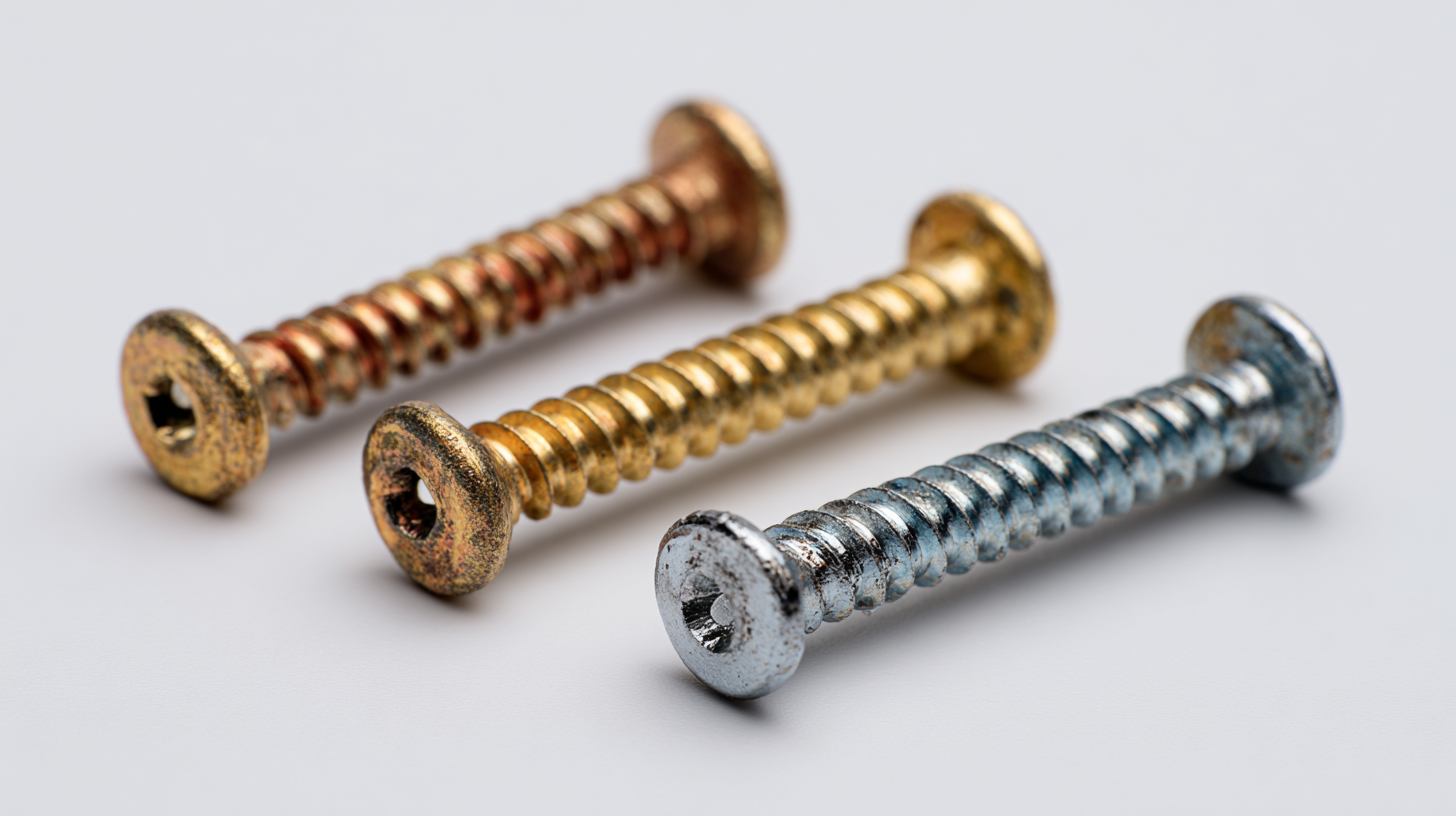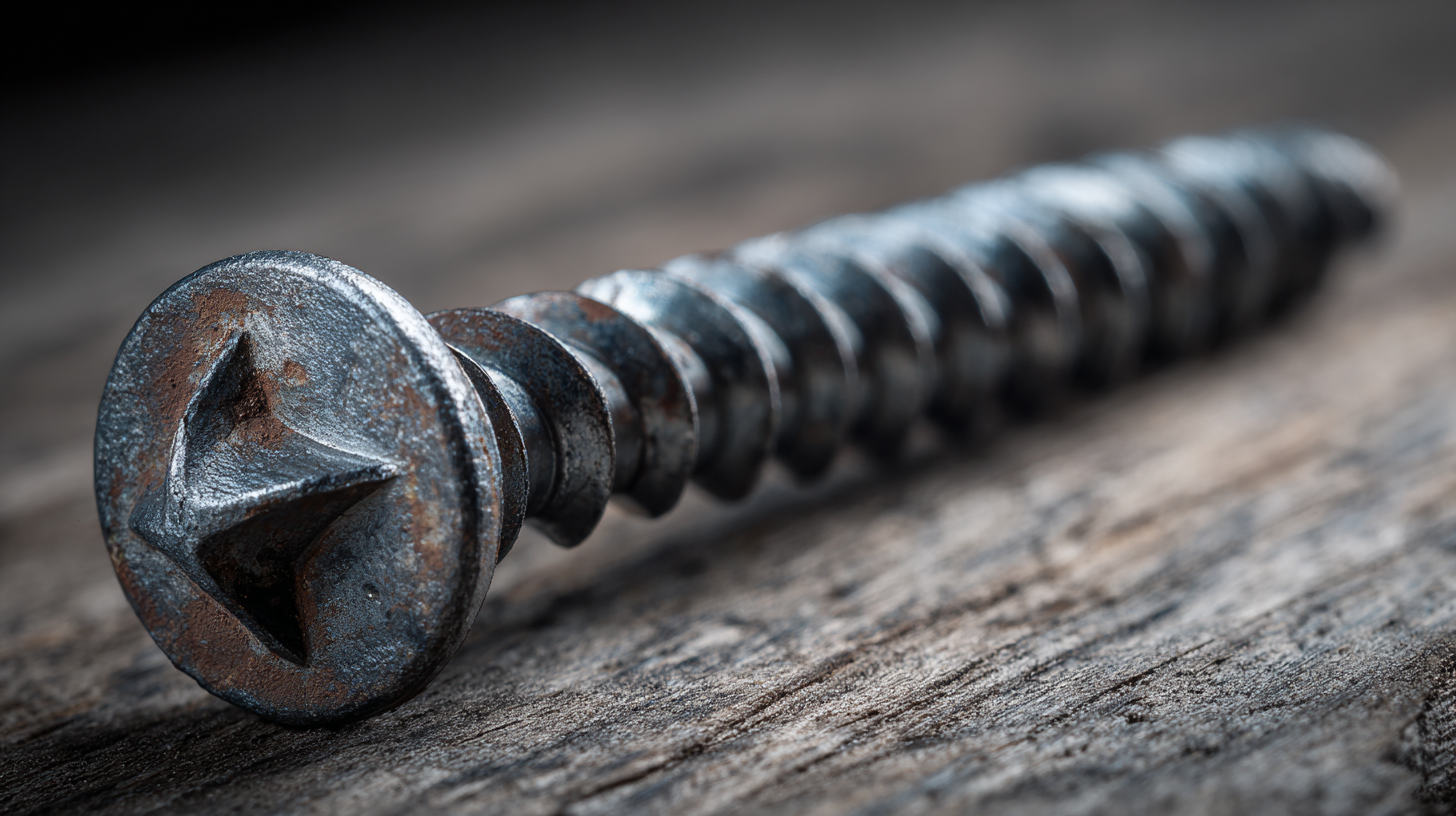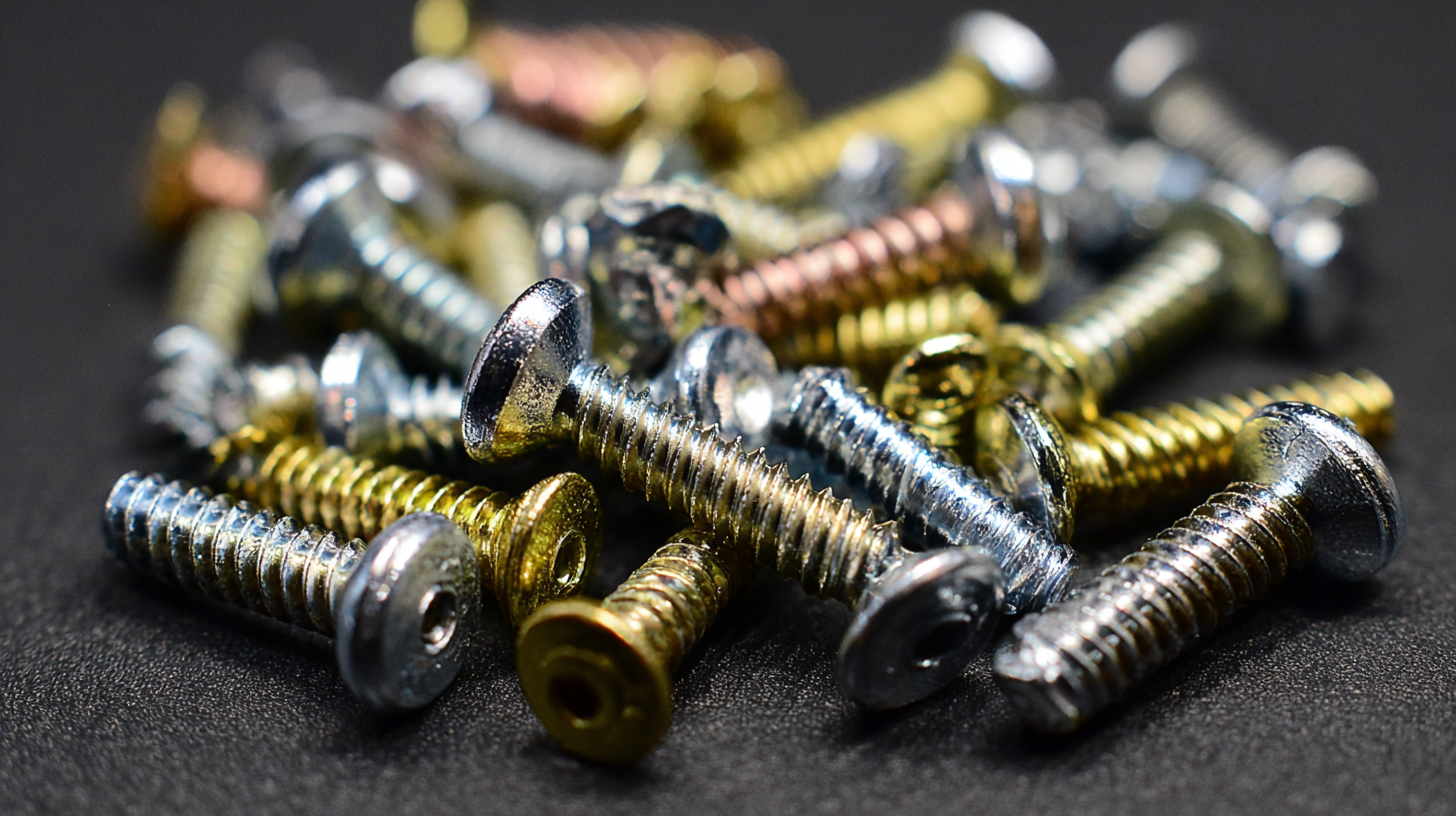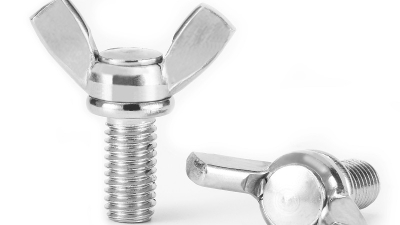
- wzqb@qb-inds.com
- Mon - Sat at 7:00AM to 6:00PM
Addressing Common Issues Faced with Flat Head Screws in Global Procurement
Table of Contents
- Challenges in Sourcing Flat Head Screws Globally
- Exploring Alternative Fasteners for Flat Head Screw Applications
- Understanding Material Options for High-Performance Flat Head Screws
- Cost-Effective Solutions: Navigating Price Variations in Fastener Markets
- Quality Control: Ensuring Consistency in Alternative Fasteners
- Innovations in Flat Head Screw Design for Global Procurement
- The Essential Guide to Choosing the Right Stainless Steel DIN316 AF Wing Bolts and Screws for Your Projects
- FAQS
- Conclusion
- Related Posts
In today’s tough global manufacturing scene, dealing with common issues related to Flat Head Screws is pretty important if you want your procurement process to run smoothly. I came across a recent report from Grand View Research that says the worldwide fasteners market could hit around USD 109.48 billion by 2025 — yeah, that's a huge number, and it just shows how much companies are craving reliable, top-quality fastening solutions.

Wenzhou Qiangbang Industrial Co., Ltd., which has been around since 2003, really dedicated itself to researching and making key components that push the high-end manufacturing industry forward. They do everything — from R&D to production, sales, and after-sales service. This guide is here to take a deep dive into the typical problems folks face with Flat Head Screws, offering some useful tips and tricks to help make procurement easier and boost overall efficiency. Honestly, understanding these issues better can help manufacturers get a grip on their supply chains, leading to smoother production and better results all around.
Challenges in Sourcing Flat Head Screws Globally
Finding flat head screws from suppliers all around the world isn’t always straightforward—it comes with its fair share of hurdles, kind of like the messy side of international shopping. One big thing to keep in mind is that quality standards really vary from place to place. If you're not careful, these differences can cause headaches when it comes to putting products together or ensuring safety. And let's not forget the logistical pain—shipping delays, customs hold-ups—they can throw a wrench in your production schedule and lead to annoying bottlenecks.
To stay on top of things, it’s a smart move to build solid relationships with trusted suppliers who really get the global market. Keep the lines of communication open and be super clear about what you need in terms of quality and design—that way, there’s less room for misunderstandings.
Pro tip: Take some time to thoroughly research your suppliers—read reviews, check their track record—anything that helps you confirm they’re reliable.
Also, spreading your sourcing across multiple suppliers can be a lifesaver if one of them hits a snag. It’s all about having backup options. And don’t forget to do regular audits on your suppliers—they’ll help you make sure everyone’s playing by your rules, and they’ll encourage continuous improvement.
If you stay proactive about tackling these challenges, you’ll be better positioned to keep a steady supply of flat head screws that actually meet your needs without any surprises.
Exploring Alternative Fasteners for Flat Head Screw Applications
Lately, you know, both the construction and manufacturing worlds have been pretty busy exploring new types of fasteners to fix some of the annoyances that come with traditional flat head screws. Take deck building, for example—it’s a pretty clear case of how we’ve pretty much moved from nails to screws because we need stuff to hold stronger and last longer. I’ve read that these new structural wood screws can actually handle more shear force than the old-school lag bolts, and honestly, they’re easier to put in too. That means if you’re a builder or DIYer, you could possibly save quite a bit on labor costs.

And it’s not just construction; the auto industry is jumping on this bandwagon too. They’re really trying to cut down on weight to get better performance out of vehicles. You know, stuff like flow-drilling screws are becoming more popular because they make tight, durable joints without messing up the material. That’s pretty important, especially for trucks and sports cars where every little bit of weight saved can mean better fuel economy and performance.
All in all, as these industries face new challenges and supply chain hiccups, I think the search for alternative fasteners isn’t going to slow down. We’re probably going to see a lot more innovations coming up, making production smoother and more efficient across the board.
Understanding Material Options for High-Performance Flat Head Screws
When it comes to global procurement, picking the right materials for high-performance flat head screws is a big deal—it's all about making sure the product lasts and remains strong over time. Lately, industry chatter suggests that demand for these screws is expected to grow by around 6.2% each year up to 2026. That’s mainly thanks to advancements in the auto and aerospace worlds, where you need screws that can handle tough conditions and perform reliably. Choosing the right material—like stainless steel, carbon steel, or titanium—can really make a difference, especially in how these screws resist rust, fatigue, and heat.
Take stainless steel, for example. It's pretty much the go-to choice for its corrosion resistance and solid strength, especially in rough environments. A study from the Global Fastener Alliance mentions that about 40% of manufacturers are leaning more towards stainless steel fasteners to meet strict industry standards. Then there's carbon steel, which is more budget-friendly. But keep in mind, it might need extra coatings to prevent rust. For really demanding, high-stress jobs, titanium screws are gaining popularity because they’re amazingly strong for their weight—a real boon for industries where cutting down weight is a priority without sacrificing performance. As companies tweak their procurement plans, getting a good grasp on these material options is key to avoiding common issues and making sure everything runs smoothly worldwide.
Cost-Effective Solutions: Navigating Price Variations in Fastener Markets
Hey, when you're dealing with the fastener market these days, especially with flat head screws, prices can really swing around and mess with your procurement plans. It’s super important to understand what causes those price shifts—things like manufacturing costs, raw material prices, and even global events all come into play and end up affecting the final price. Because of that, having a flexible buying strategy is a smart move. It helps you handle those ups and downs without sacrificing quality or reliability.
Here's a tip: if you want to avoid wild price swings, think about locking in prices with suppliers through long-term contracts. It’s a great way to protect yourself from sudden spikes and keep a steady supply of flat head screws coming in.
Also, don’t forget to look into alternative sources. Sometimes, regional suppliers can offer more stable pricing compared to international ones, especially since shipping costs and tariffs can vary a lot. By spreading out your sourcing, you not only get a buffer against price hikes but also boost your bargaining power.
Another tip—make it a habit to keep an eye on market trends and how your suppliers are performing. Staying in the loop helps a ton when it’s time to negotiate and makes sure your purchasing decisions match what's really going on in the market.
Quality Control: Ensuring Consistency in Alternative Fasteners
Making sure that alternative fasteners, especially flat head screws, are consistent is a big deal for manufacturers trying to smooth out their global sourcing. A recent report from the International Fastener Distributors Association (IFDA) points out that when fastener quality isn’t up to snuff, it can cause some pretty major hiccups in operations. In fact, they estimate that failures can cut productivity by around 15%. That really underscores how important it is to have solid quality checks in place throughout the supply chain.
To avoid these kinds of issues, companies should consider setting up standardized testing routines and working closely with suppliers to establish clear benchmarks. The Fastener Quality Act (FQA) has shown that when you stick to a consistent quality verification process across your supplier network, you can reduce failure risks by up to 30%. At the end of the day, focusing on quality control helps manufacturers ensure their alternative fasteners meet all necessary specifications and keep their products reliable. Plus, it helps boost overall efficiency, which is a win-win in the long run.
Addressing Common Issues Faced with Flat Head Screws in Global Procurement - Quality Control: Ensuring Consistency in Alternative Fasteners
| Issue | Description | Impact Level | Mitigation Strategy | Frequency of Occurrence |
|---|---|---|---|---|
| Dimensional Variations | Inconsistencies in screw dimensions can lead to improper fits. | High | Implement rigorous dimensional inspections on production batches. | Occasional |
| Material Quality | Use of substandard materials can compromise strength. | Critical | Source materials from certified suppliers only. | Frequent |
| Coating Issues | Inconsistent coatings can lead to corrosion or aesthetic flaws. | Medium | Conduct regular checks on coating processes and standards. | Occasional |
| Supplier Reliability | Inconsistent delivery times and quality from suppliers. | High | Maintain a diverse supplier base and evaluate supplier performance regularly. | Frequent |
Innovations in Flat Head Screw Design for Global Procurement
In today's super-fast global market, dealing with common issues related to flat head screws is pretty crucial if you want your high-end manufacturing to run smoothly. The design of these screws has come a long way, with lots of new ideas aimed at making them more functional, cutting down assembly time, and boosting overall efficiency. I recently read an industry report that says using optimized screw designs can actually up your productivity by around 30%. So, it’s definitely a smart move for companies to invest in good quality components and stay ahead of the game.

At Wenzhou Qiangbang Industrial Co., Ltd., we totally get how important it is to push the boundaries and improve screw design. Our dedicated R&D team is always tinkering and exploring new ways to make flat head screws perform better and last longer—because the manufacturing world is always changing, and demands keep growing. For instance, using materials that resist corrosion better can help produce screws that stand up to tough environments and last even longer.
Tip: When you’re picking out flat head screws, don’t forget to think about the material and coating options. Spending a bit more on high-quality alloys can really save you money on maintenance down the line. Also, make sure the torque specs match what your project needs—that way, you avoid any headaches during assembly. Little things like screw design details can actually make a huge difference in how smoothly your production runs.
The Essential Guide to Choosing the Right Stainless Steel DIN316 AF Wing Bolts and Screws for Your Projects
When it comes to selecting the ideal stainless steel DIN316 AF wing bolts and screws for your projects, understanding their unique features and applications is essential. Wing bolts, or wing screws, are distinct due to their elongated 'wings' that facilitate easy hand operation, making them a popular choice for various fastening needs. Their design allows for quick adjustments and easy installation, which is particularly beneficial when working in tight spaces or when frequent adjustments are necessary.
These versatile fasteners are manufactured to the DIN 316 AF standard, ensuring that they meet high-quality specifications suited for numerous applications. When paired with wing nuts, they create a powerful fastening solution that can securely hold materials together while providing the flexibility needed to make adjustments from various positions. This combination is perfect for applications in construction, automotive, or even DIY projects where ease of handling and reliability are paramount. Whether you are working on a large structural project or a small home improvement task, opting for stainless steel DIN316 AF wing bolts and screws can significantly enhance your project's efficiency and effectiveness.
FAQS
: Alternative fasteners are fasteners other than traditional flat head screws, such as structural wood screws and flow-drilling screws. They are being explored to address common issues with flat head screws, offering improved strength, durability, and ease of installation to reduce labor costs.
New structural wood screws provide higher design shear strength compared to traditional lag bolts and facilitate easier installation, which helps reduce labor costs in construction.
The automotive industry is shifting towards alternative fasteners to reduce vehicle weight, enhance performance, and improve fuel efficiency. Flow-drilling screws, in particular, help create strong joints while maintaining material integrity.
Rigorous quality control measures are crucial for ensuring consistency in alternative fasteners, as inconsistencies can lead to significant operational setbacks. A consistent quality verification process can reduce the risk of fastener failure by up to 30%.
Manufacturers can improve productivity by adopting optimized screw designs that enhance functionality and reduce assembly time, potentially boosting productivity by up to 30%.
Advancements in screw design include integrating materials with better corrosion resistance and optimizing designs to enhance performance and reliability in various manufacturing applications.
Companies should consider the material and coating options available for flat head screws, as well as ensure that torque specifications align with project requirements to avoid assembly issues.
Investing in screws made from high-quality alloys can significantly reduce maintenance costs over time by ensuring durability and performance under various environmental conditions.
Industries are facing evolving demands and supply chain challenges, prompting them to explore alternative fasteners as a way to innovate and improve efficiency in production processes.
Collaboration with suppliers allows manufacturers to implement standardized testing protocols and benchmark assessments, which are essential for maintaining consistent quality and reducing operational risks.
Conclusion
Today’s global scene for sourcing flat head screws isn’t exactly a walk in the park. Companies are facing all sorts of hurdles—like dealing with fluctuating prices and making sure the quality stays consistent, especially when trying out different fasteners. As businesses look for ways to cut costs without sacrificing performance, it’s really important to understand the wide range of materials out there for these high-performance screws. Companies like Wenzhou Qiangbang Industrial Co., Ltd., which was founded back in 2003, are really leading the way with their focus on R&D and innovative manufacturing techniques to tackle these challenges.
Plus, the whole push towards exploring alternative fasteners just shows how market needs are shifting. It underscores how crucial quality control is if you want to keep standards high. Innovations in flat head screw design are opening up new possibilities, making them more functional and aligning with the demands of high-end manufacturing. As global sourcing continues to evolve, I hope the insights shared here help businesses make smarter choices when it comes to their procurement strategies.
Related Posts
-

Crafting Excellence: How Chinese Hollow Wall Anchors Are Redefining Global Standards
-

Global Leaders in Cabinet Hardware Manufacturing Excellence
-

Innovative Solutions to Common Challenges with Best Shelf Pins in Industrial Applications
-

10 Essential Tips for Choosing the Best Threaded Rod for Your Projects
-

Navigating Export Certification for the Best Thread Rod Industry with 5 Essential Insights
-

Addressing Common Issues with the Best Home Hardware Flyer: Your Ultimate Guide

